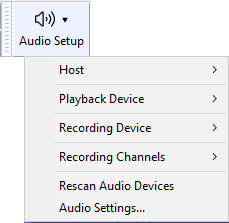
Now that you know you are getting sound into the computer and you have made your Audacity settings, it is time to set up your recording device.
There are many other settings that can be made in your Preferences do take some time to explore and understand these.
Click on the Audio Setup button in the the top tooldock, for details please see Audio Setup Toolbar.

This selects the particular interface with which Audacity communicates with your chosen recording and playback devices.
The number of different settings for recording is somewhat daunting, reflecting the many options for recording. Basically you can leave the settings at the default, and record just fine. However you might want to check this Tutorial on recording settings to find out more.
The "Audio Host" is the interface between Audacity and the sound device. On Windows, the choice is between the following audio interfaces.
On Mac the only choice is Core Audio.
On Linux there is often only one option: ALSA. Other options could be OSS and/or Jack Audio Connection Kit (also known as "Jack" or "Jackd").
For Playback device, choose the named sound device your headphones or speakers are connected to (not a device like Microsoft Sound Mapper that uses the system default device). If you are using a USB-connected guitar, microphone or keyboard on Windows, you may also need to reset the default system playback device to your computer sound device in order to hear audio in other applications.
Set the volume level of your recording input, click in the Recording Meter, or click on the microphone icon and click Enable Silent Monitoring.
![]()
Now that you know that you can hear what Audacity is playing you can continue setting up for recording.
Choose your preferred recording device from the Recording Device dropdown menu in the Audio Settings preferences.
In the Recording Channels dropdown menu choose whether you want to record in mono (1 channel) or stereo (2 channels). In general if you are recording a microphone or guitar you will want to record in mono. If you are recording a keyboard and the keyboard has stereo outputs you will want to record in stereo.
If your line-in or other inputs are not shown in Device Toolbar, go to the system mixer for Windows, show and enable the missing inputs, then use Transport > Rescan Audio Devices or restart Audacity.
If you prefer, you can make the above settings in Audacity's Device Toolbar.
The Device Toolbar, shown below, is not displayed by default in Audacity. To enable it, click on View > Toolbars and check on Device Toolbar.

You may want to expand the size of the Device Toolbar by dragging right on the drag-handle / drag-bar Resizer.